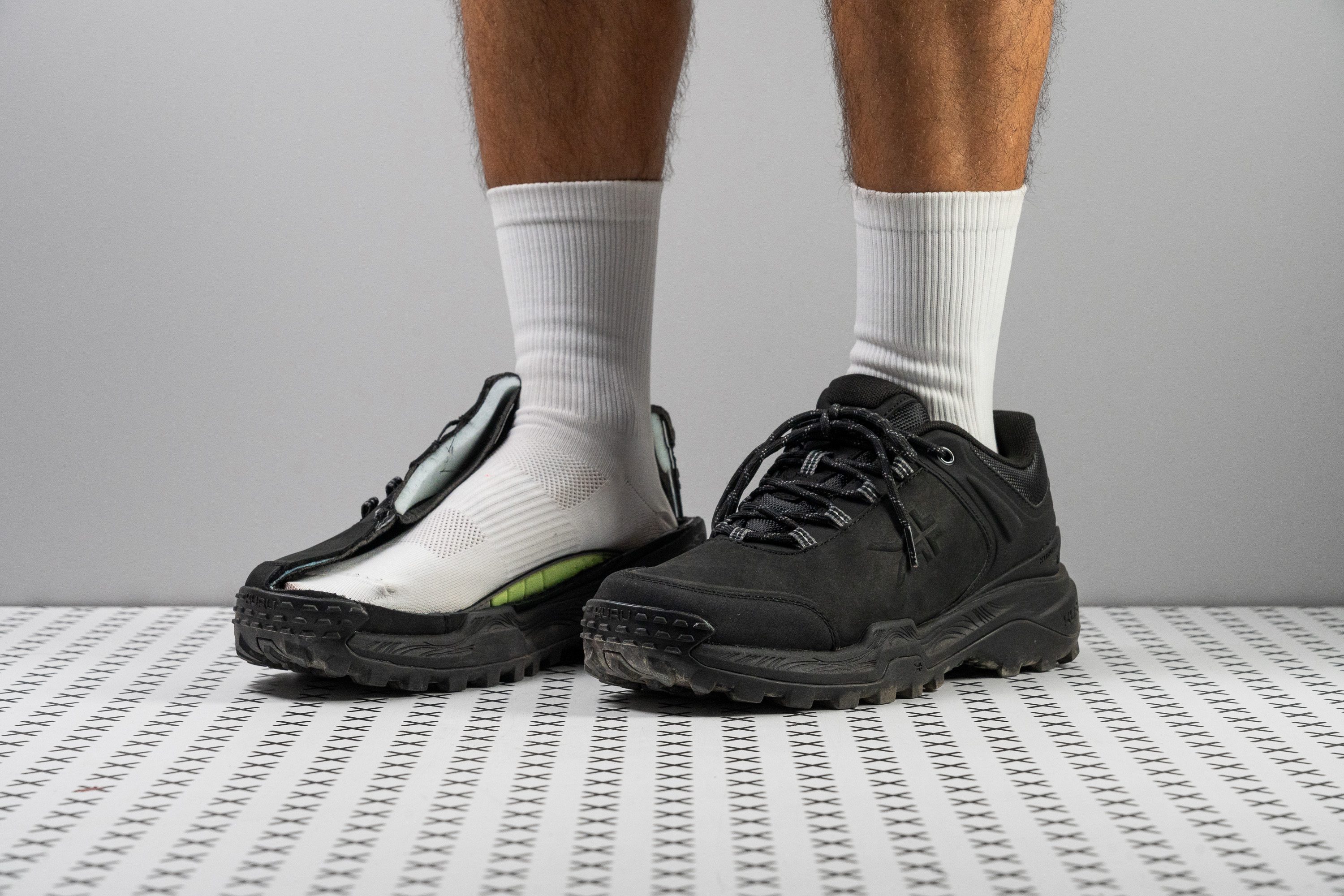Our verdict
- Top pick in best plantar fasciitis hiking shoes
- Top pick in best flat feet hiking shoes
Pros
- Orthopaedic foot support
- Comfortable in-shoe experience
- True to medium width
- Excellent grip on varied terrain
- Fantastic lateral stability
- Tough nubuck leather upper
Cons
- Only moderate shock absorption
- Heavier than average
- Outsole and inner lining lack durability
Audience verdict
- Top 3% in hiking shoes
- Top 6% in winter hiking shoes
Comparison
The most similar hiking shoes compared
+ + Add a shoe | |||||
|---|---|---|---|---|---|
| Audience score | 93 Superb! | 88 Great! | 84 Good! | 80 Good! | |
| Price | £180 | £125 | £70 | £180 | |
| Trail terrain | LightModerate | Moderate | LightModerate | Moderate | |
| Shock absorption | Low | High | Moderate | - | |
| Energy return | Moderate | Low | Moderate | - | |
| Weight lab Weight brand | 16.2 oz / 458g 14 oz / 397g | 11.6 oz / 329g 12.3 oz / 350g | 13.4 oz / 380g 12.3 oz / 350g | 14.5 oz / 410g 14.9 oz / 423g | |
| Lightweight | ✗ | ✓ | ✓ | ✗ | |
| Breathability | Warm | Breathable | Breathable | Breathable | |
| Use | Day Hiking | Day HikingSpeed HikingLight Hiking | Day HikingLight HikingBeginners | Day HikingLight HikingUrban hiking | |
| Orthotic friendly | ✓ | ✓ | ✓ | ✓ | |
| Drop lab | 12.1 mm | 15.0 mm | 13.7 mm | 8.0 mm | |
| Size | - | Half size small | True to size | True to size | |
| Midsole softness | Soft | Soft | Balanced | Balanced | |
| Difference in midsole softness in cold | Normal | Normal | Big | Small | |
| Torsional rigidity | Stiff | Stiff | Stiff | Stiff | |
| Heel counter stiffness | Stiff | Flexible | Moderate | Moderate | |
| Stiffness | Moderate | Moderate | Flexible | Stiff | |
| Outsole hardness | - | Average | Average | Average | |
| Material | - | Mesh | LeatherMeshSuede | Knit | |
| Season | Winter | SummerAll seasons | SummerAll seasons | SummerAll seasons | |
| Toebox durability | Good | Very good | Very good | Very bad | |
| Heel padding durability | Bad | Bad | Bad | Bad | |
| Outsole durability | Decent | Good | Decent | Decent | |
| Width / fit | Medium | Medium | Medium | Narrow | |
| Toebox width | Medium | Wide | Medium | Medium | |
| Lug depth | 3.7 mm | 3.7 mm | 3.2 mm | 3.7 mm | |
| Heel stack lab | 38.6 mm | 38.8 mm | 32.7 mm | 39.0 mm | |
| Forefoot | 26.5 mm | 23.8 mm | 19.0 mm | 31.0 mm | |
| Widths available | Normal | NormalWide | NormalWide | Normal | |
| Technology | - | - | - | Vibram | |
| Heel tab | None | Finger loop | Finger loop | Finger loop | |
| Removable insole | ✓ | ✓ | ✓ | ✓ | |
| Ranking | #1 Top 3% | #9 Top 26% | #21 Bottom 40% | #26 Bottom 25% | |
| Popularity | #28 Bottom 20% | #6 Top 18% | #25 Bottom 28% | #35 Bottom 1% |
Who should buy
The KURU Ridge Motion appeals to people who:
- want to enjoy the great outdoors without suffering from foot pain
- have foot conditions that require orthopaedic shoes (plantar fasciitis, overpronation, arthritis, diabetes, etc.)
- prefer leather shoes to feel at home both on the trail and in the city
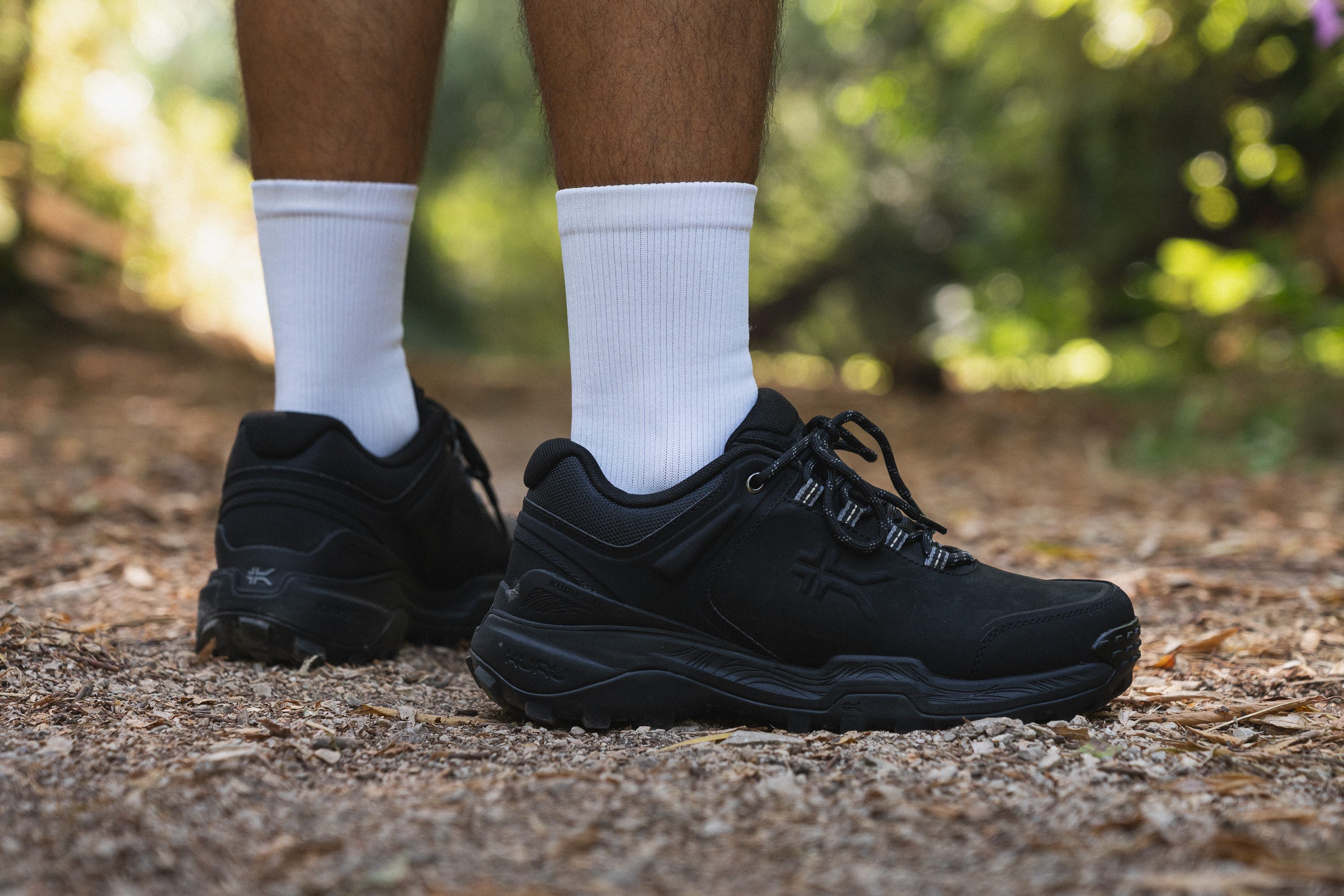
Who should NOT buy
If you like the idea of a well-cushioned and supportive hiking shoe but not necessarily an orthopaedic one, you might enjoy the Adidas Terrex Free Hiker 2.0 Low GTX or the HOKA Anacapa 2 Low GTX.
Both shoes provide much higher shock absorption, are lighter, and more durable than the KURU Ridge Motion at the same price point.
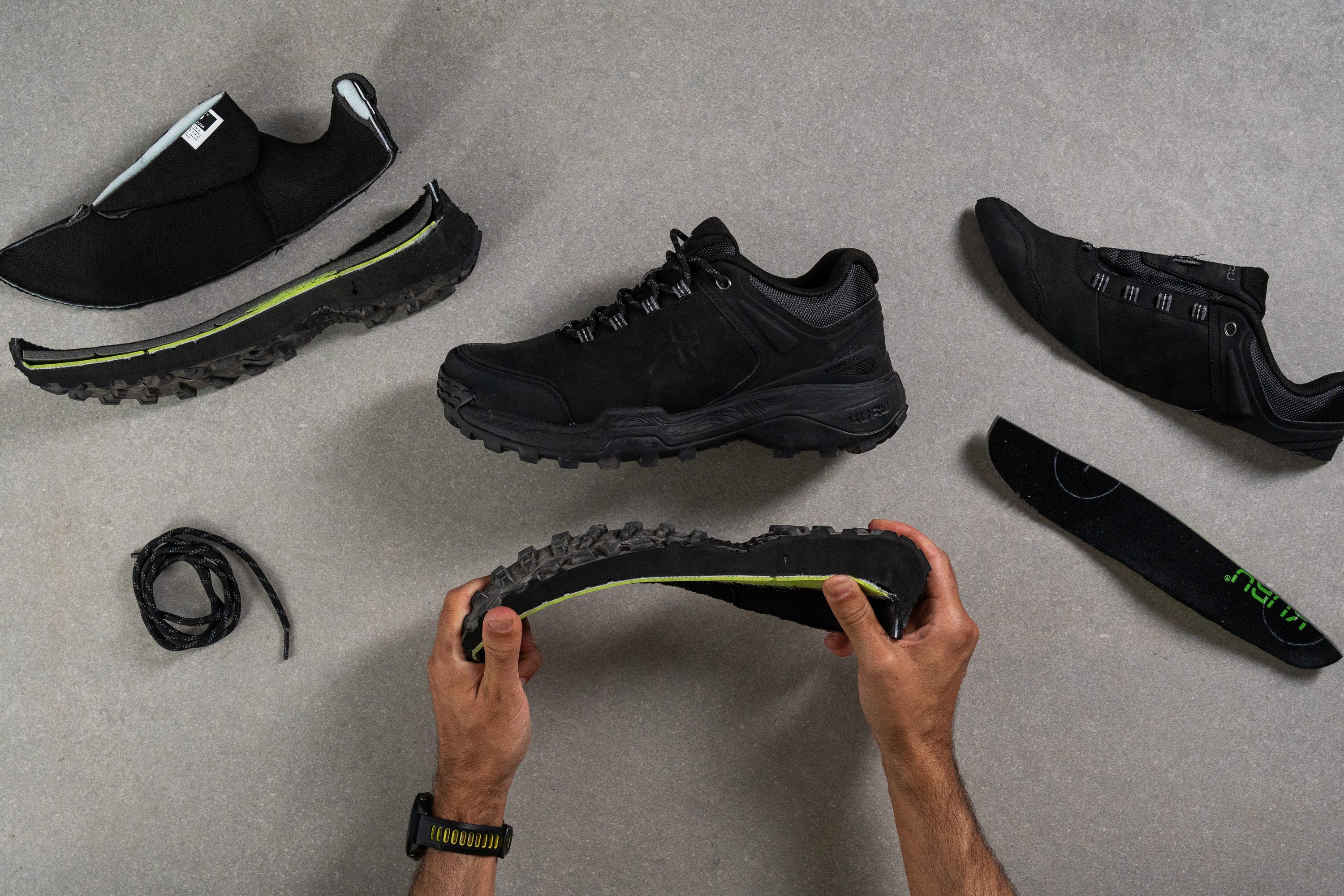
Cushioning
Shock absorption
KURU promised 'fatigue-fighting' shock absorption in the Ridge Motion, but we got just a moderate reading of 100 SA in its heel. And while the shoe still makes it to the cushioned category, we expected more impact protection from such a high-stacked and expensive shoe.
Its close competition, the Adidas Terrex Free Hiker 2.0 Low GTX (126 SA) and the HOKA Anacapa 2 Low GTX (118 SA), returned significantly higher measurements.
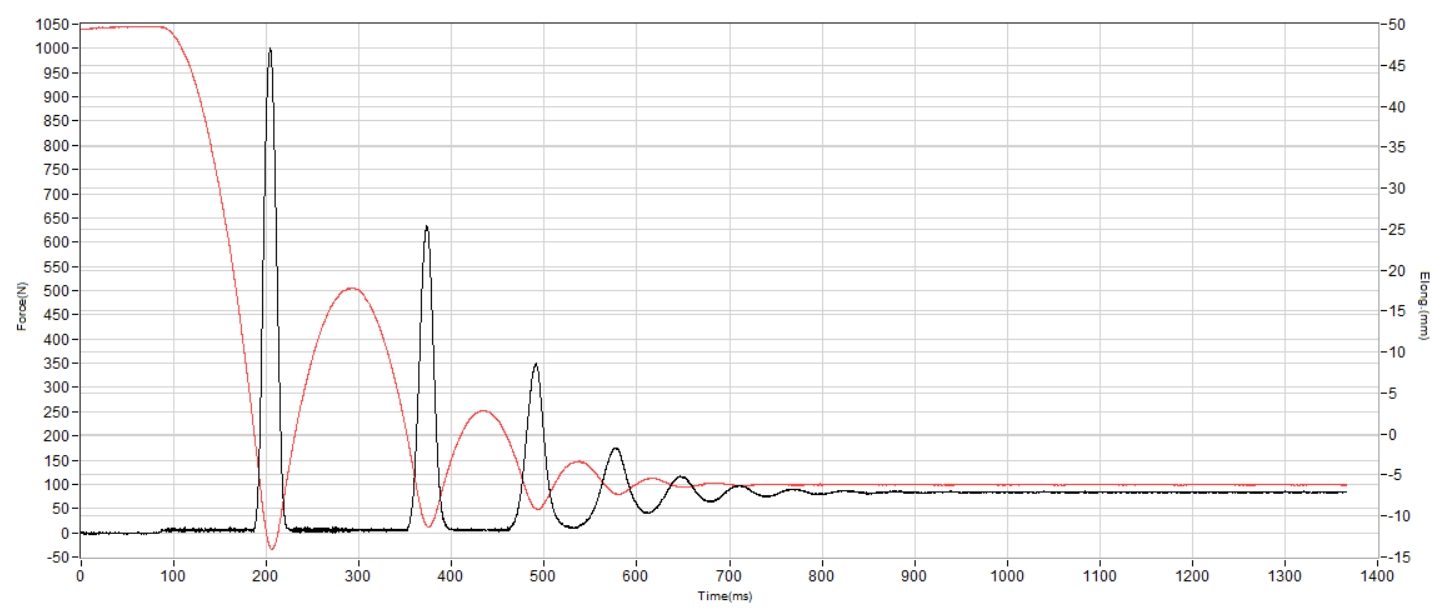
| Ridge Motion | 100 SA |
| Average | 104 SA |
Energy return
With a moderate energy return of 45.8%, the Ridge Motion offers a grounded ride as opposed to a springy one.
Paired with this KURU shoe's heftier weight, hiking at a brisk pace could be a problem. But you get a more stable and planted experience in return.
| Ridge Motion | 45.8% |
| Average | 50.2% |
Heel stack
The Ridge Motion's towering heel stack of 38.6 mm raises it above most other hiking shoes in our catalogue.
We could feel a tangible buffer between our feet and the ground, but it also made us feel isolated from the trail. This is not a shoe for someone who values proprioception, but is great at fending off rocks, roots, and other obstacles.
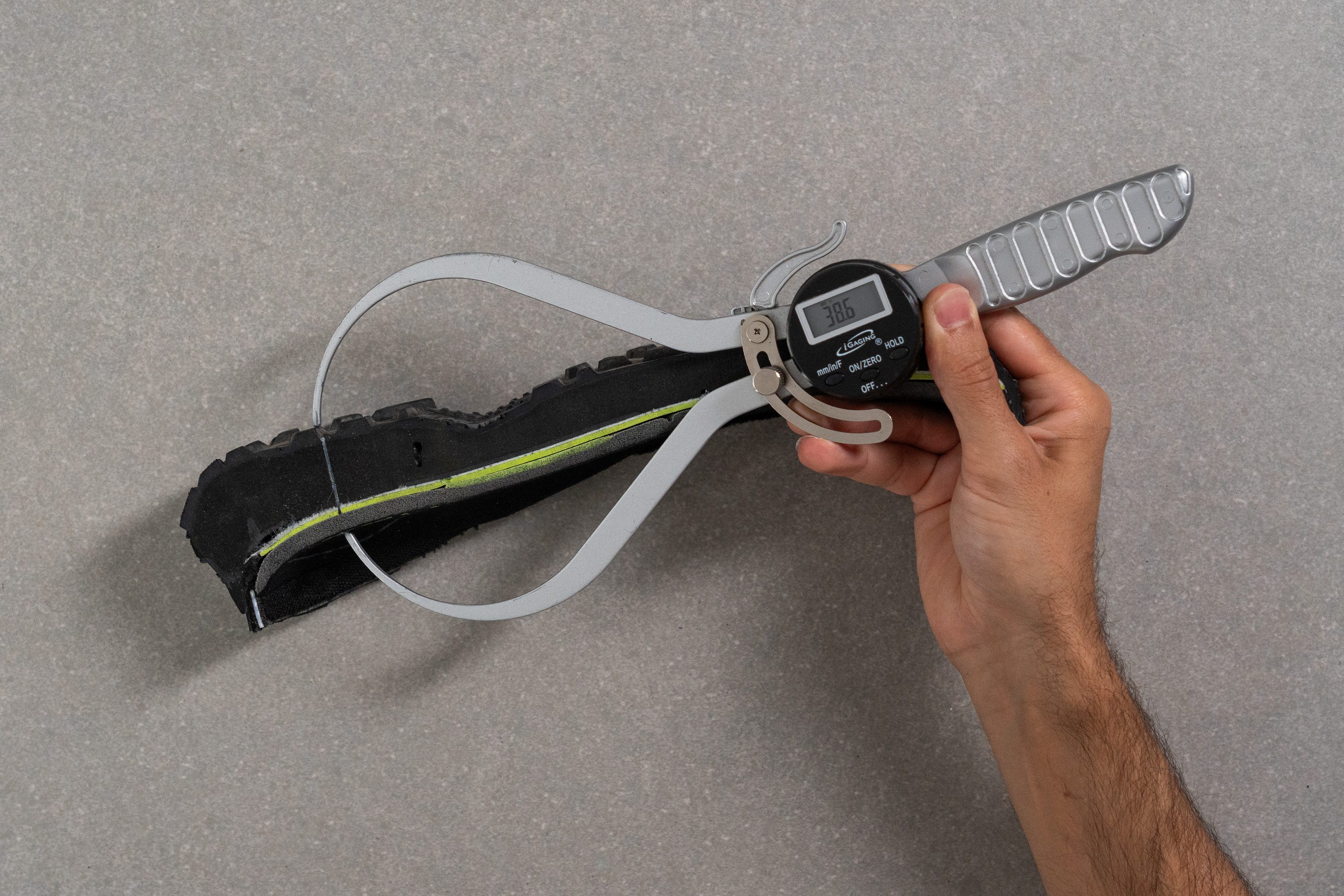
| Ridge Motion | 38.6 mm |
| Average | 32.8 mm |
Forefoot stack
Our calliper also showed an above-average reading in the shoe's forefoot. At 26.5 mm, it is notably thicker than most other hiking boots under the ball of the foot.
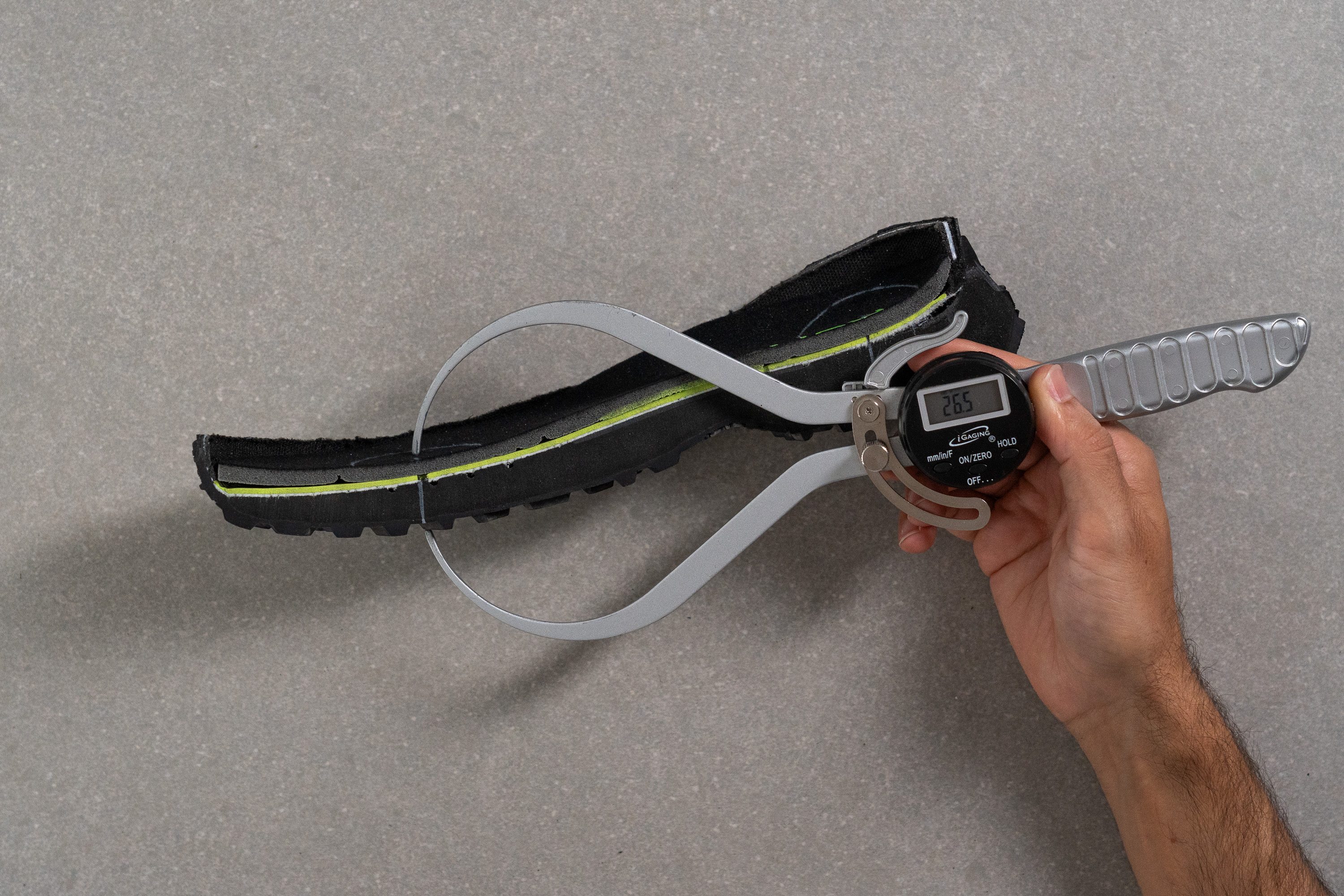
| Ridge Motion | 26.5 mm |
| Average | 22.0 mm |
Drop
Contrary to KURU's product specs, we measured the Ridge Motion's heel-to-toe drop at 12.1 mm and not 9 mm (as stated). While not many hikers can feel the difference, it is our duty to call out these discrepancies.
But in both cases, the slightly elevated heel puts the foot in a more ergonomic position to sustain long hours of walking with less stress and strain on the heel, Achilles, and calves. Especially when a heavier backpack is involved.
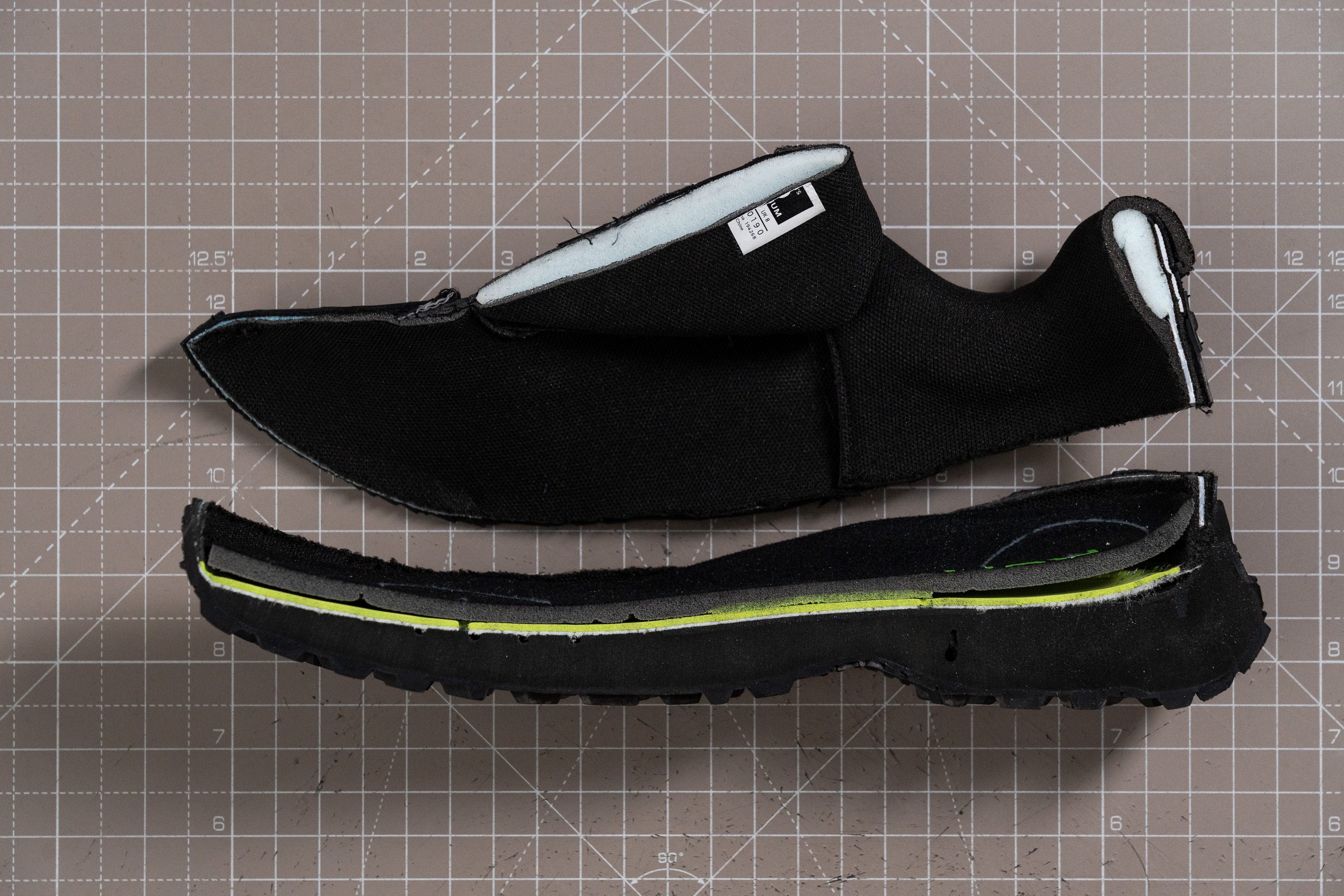
| Ridge Motion | 12.1 mm |
| Average | 10.7 mm |
Midsole softness
The KURUCLOUD midsole foam of the Ridge Motion turned out to be a moderately soft compound.
Pressing our durometer against it returned a below-average reading of 22.0 HA. This means that the material is softer than average but not overly plush. It is still in the balanced range, which makes it feel comfortable without being wobbly.
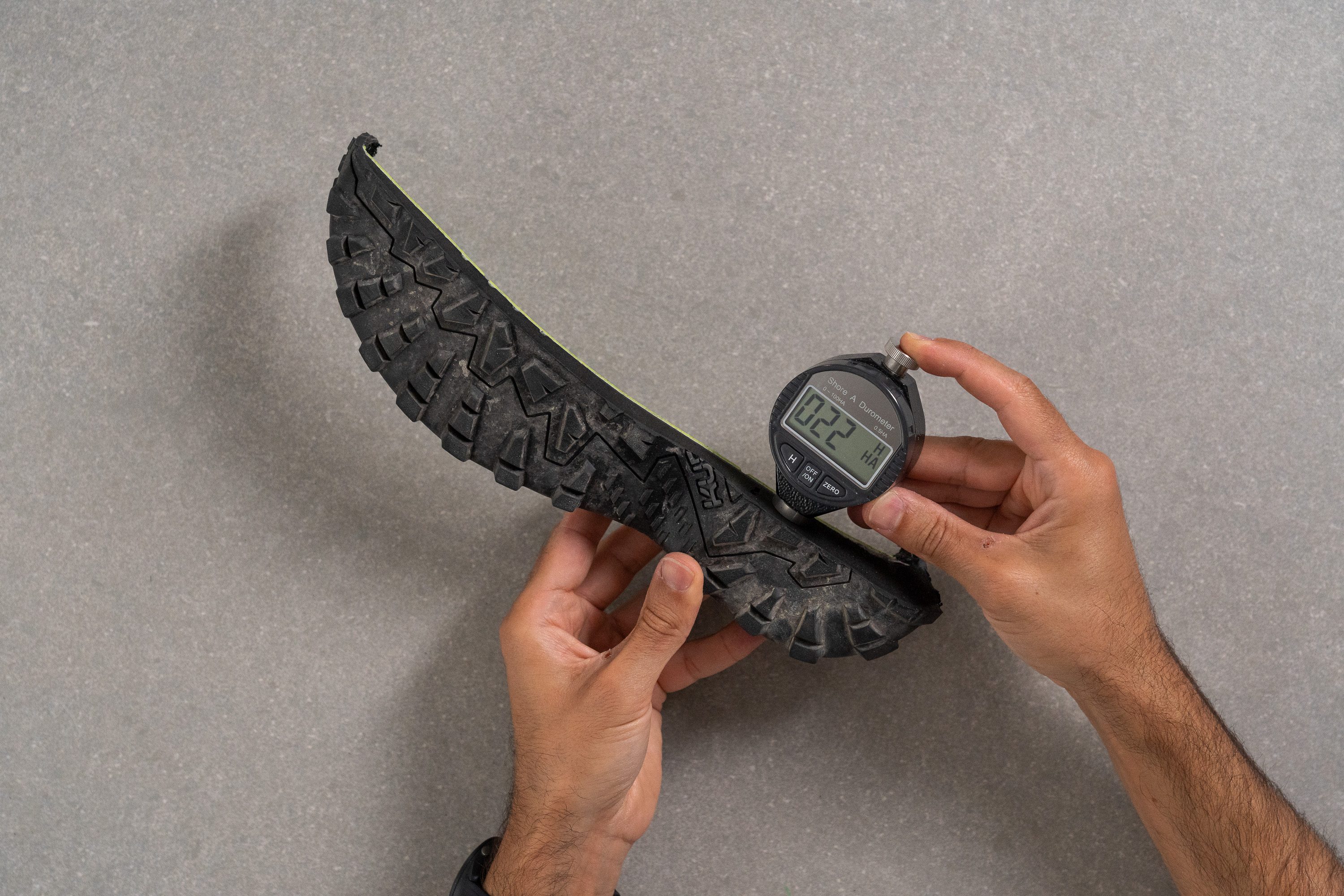
| Ridge Motion | 22.0 HA |
| Average | 27.0 HA |
Rocker
Putting the shoe against the rulers, we can see how moderate its heel bevel and toe rocker are. But it is a normal curvature for a hiking boot with a more traditional appeal. The angles are small, but they do add a touch of smoothness to the ride.
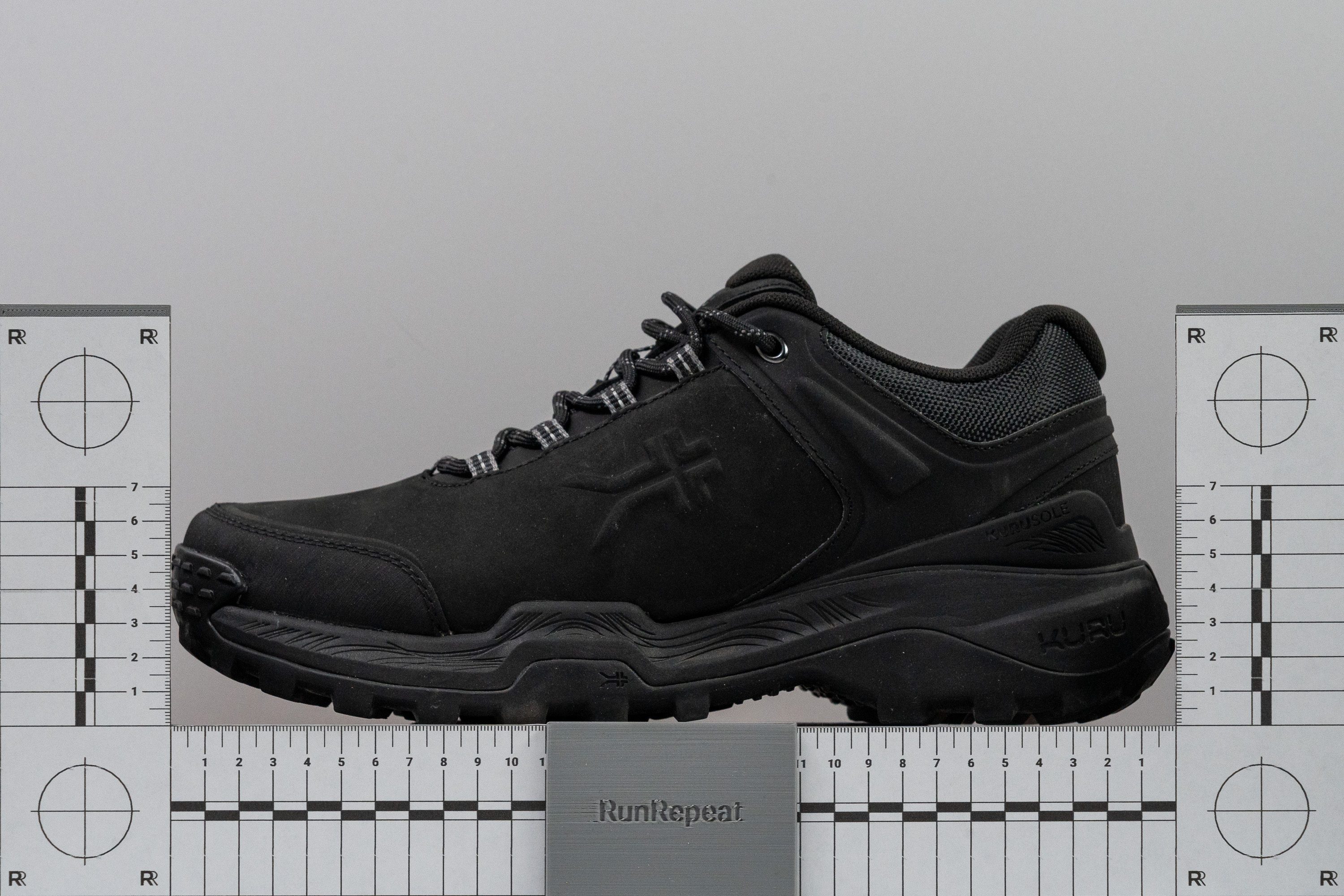
KURUSOLE
A very unique component of any KURU shoe is, of course, the KURUSOLE.
Made of pliable TPU, it is the brand's patented heel cup, which adjusts to each heel strike, keeping the foot's natural fat pad nice and supported.
During our on-foot testing, the shoe indeed felt easy on the foot and didn't aggravate any of our existing discomfort. But it would have to earn a higher shock absorption score in our lab test for us to be zealous about its cushioning properties.
Size and fit
Size
Width / Fit
Considering that the KURU Ridge Motion is available in medium width only, it is even more important to know how much space to expect inside of it.
As soon as the shoe's gel mould solidified, we measured its widest part with a digital calliper. Showing 92.3 mm in the ball of the foot area, it proved to be within the medium range of hiking shoes in a men's US size 9.
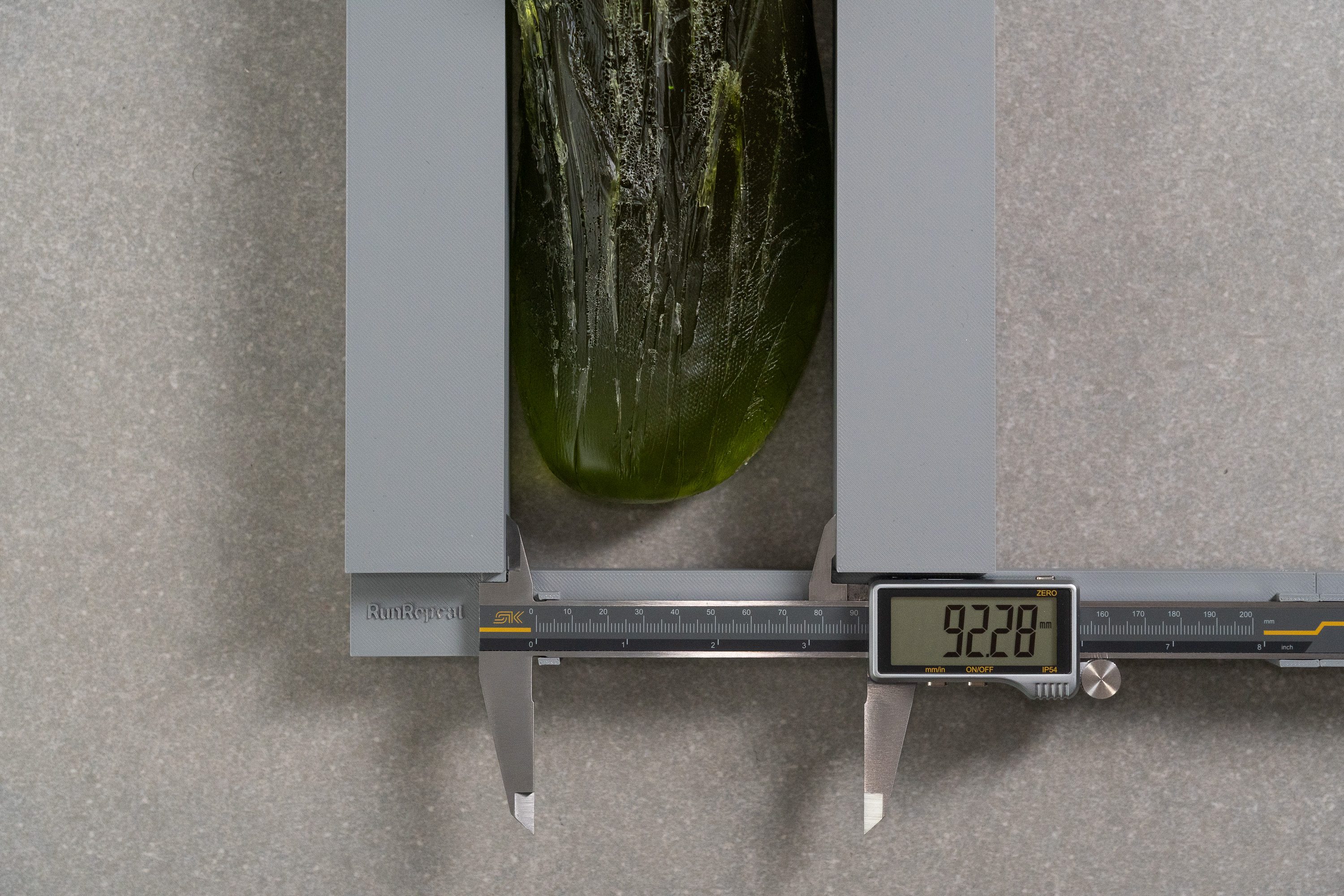
| Ridge Motion | 92.3 mm |
| Average | 94.1 mm |
Toebox width
KURU promises a wide toebox in the Ridge Motion, but we found it to be just a millimetre short of the wide category, by our standards.
Measuring its mould's width in the big toe area, we got 74.0 mm. Great for medium-width feet but not as spacious as Altra, KEEN, or Teva toeboxes.
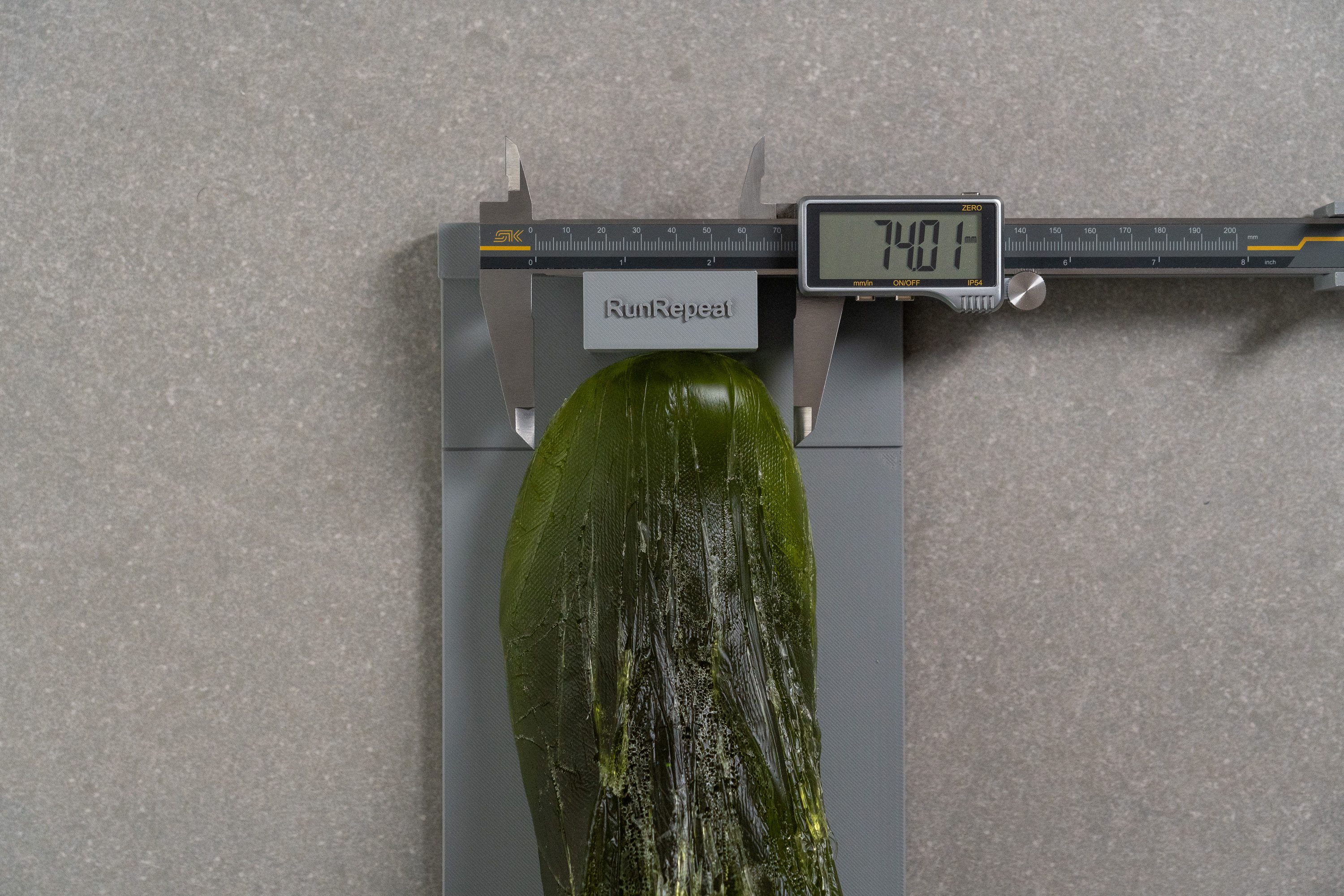
| Ridge Motion | 74.0 mm |
| Average | 72.5 mm |
Toebox height
With a toebox height of 28.4 mm, the shoe's vertical space also proved to be on par with the average.
Despite its tough leather upper, the Ridge Motion didn't restrict our toes at all.
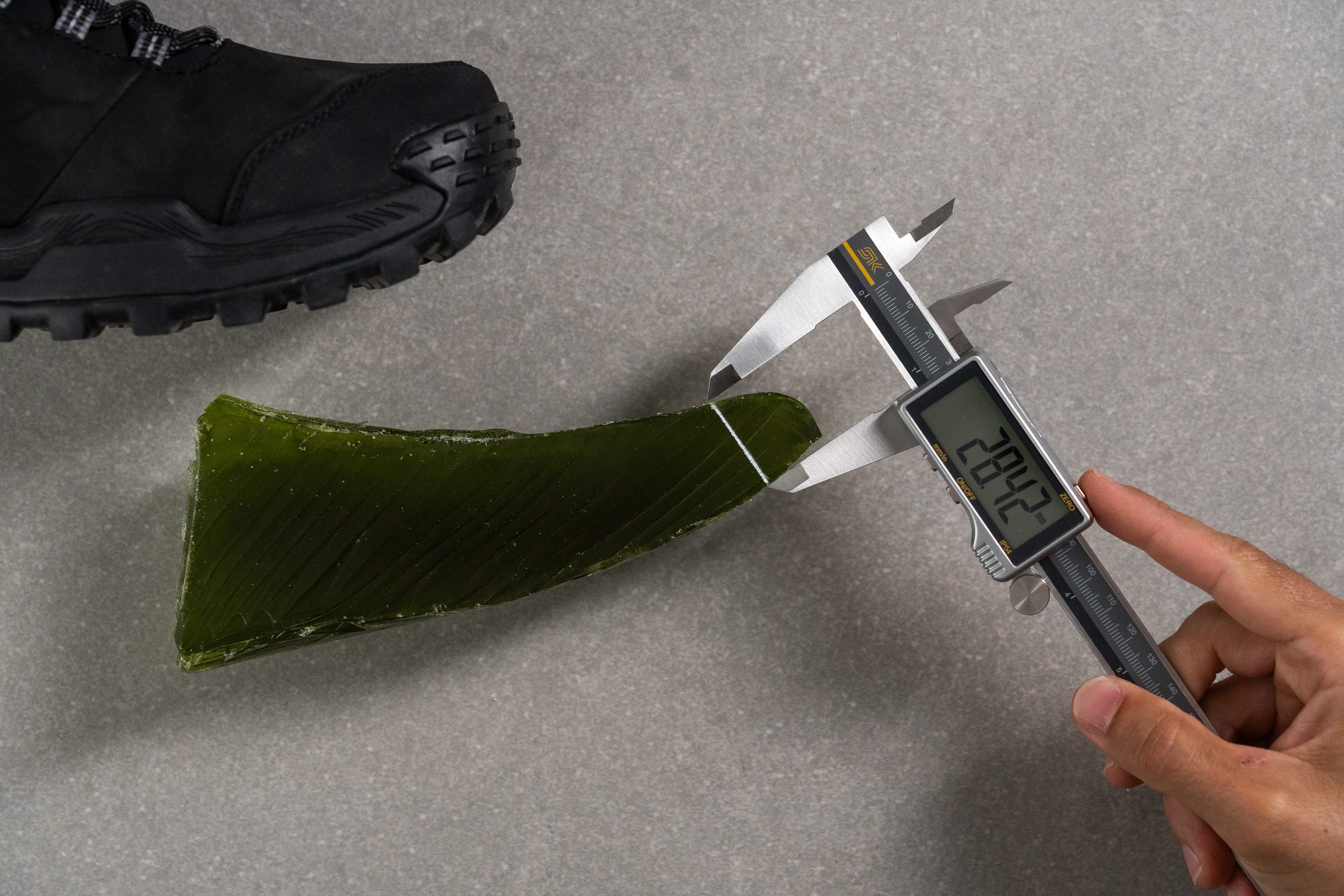
| Ridge Motion | 28.4 mm |
| Average | 28.0 mm |
Traction / Grip
Forefoot traction
Sliding the forefoot part of the shoe's outsole against wet concrete, we recorded a nod-worthy result of 0.58. This is a solid coefficient of friction for a hiking shoe, which proves the Ridge Motion's gripping capacity on slick and smooth surfaces like granite (wet or dry).
| Ridge Motion | 0.58 |
Lug depth
We also found that its moderately toothy lugs of 3.7 mm make the KURU Ridge Motion versatile enough for mixed terrain, including some mossy logs, light mud, and loose rock, among other obstacles.
And it won't feel out of place if you have to walk on hard-packed trails or asphalt roads.
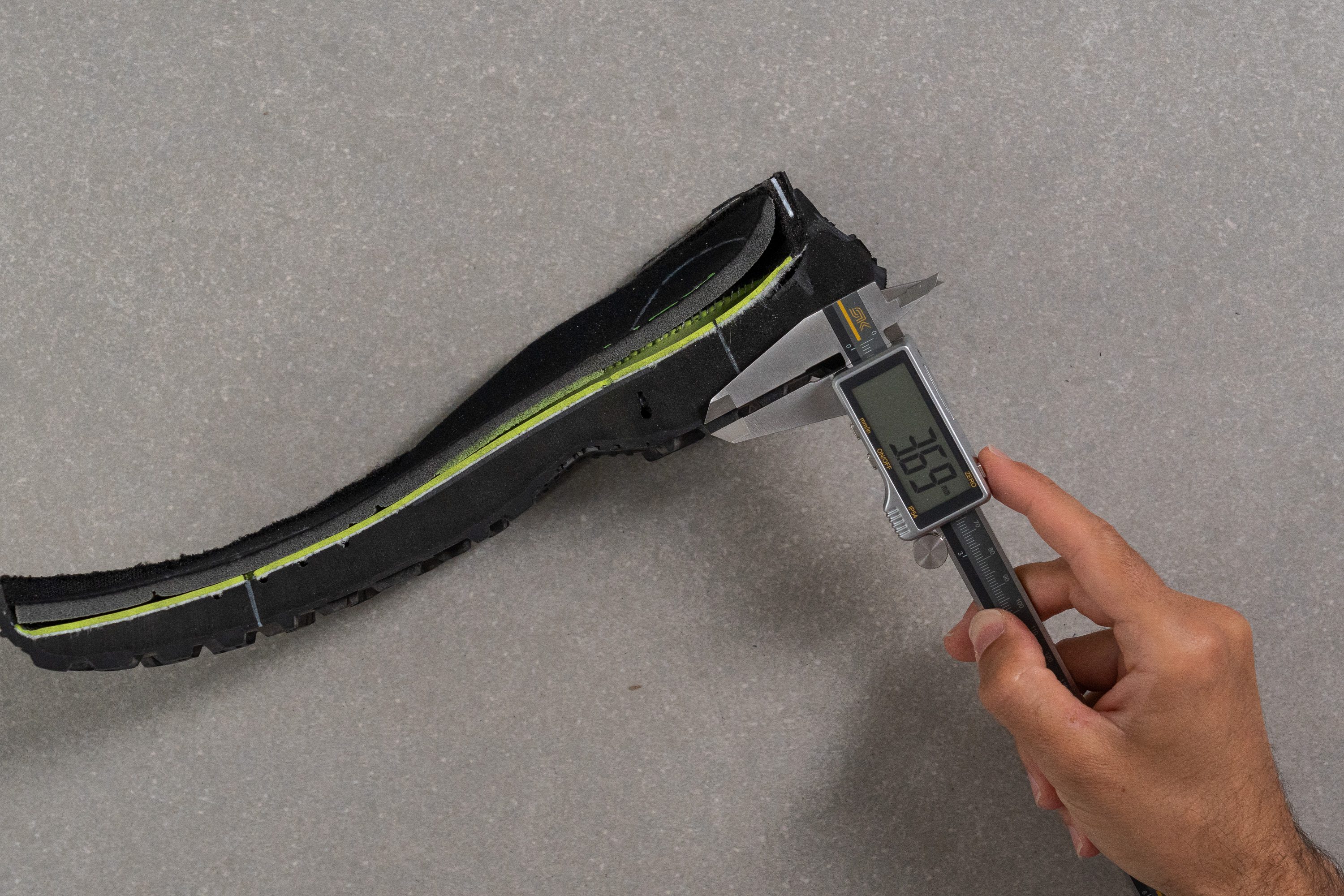
| Ridge Motion | 3.7 mm |
| Average | 4.0 mm |
Outsole design
The multi-directional shape of the Ridge Motion's treads makes the shoe reliable on hilly terrain, and the pronounced heel brake helps with steep descents.
We also noticed that the lugs themselves are wide, which increases the surface area for latching onto smooth boulder faces.

Flexibility / Stiffness
The KURU Ridge Motion comes across as a very stiff shoe that requires an arduous break-in period. But that's not true!
Checking the shoe's forefoot stiffness, we found that it's only slightly stiffer than the average hiking shoe at 20.9N (that's how much force it takes to bend it by 30 degrees).
There is enough rigidity to keep the ride stable on uneven terrain, but also enough pliability to accommodate a more or less natural foot movement.
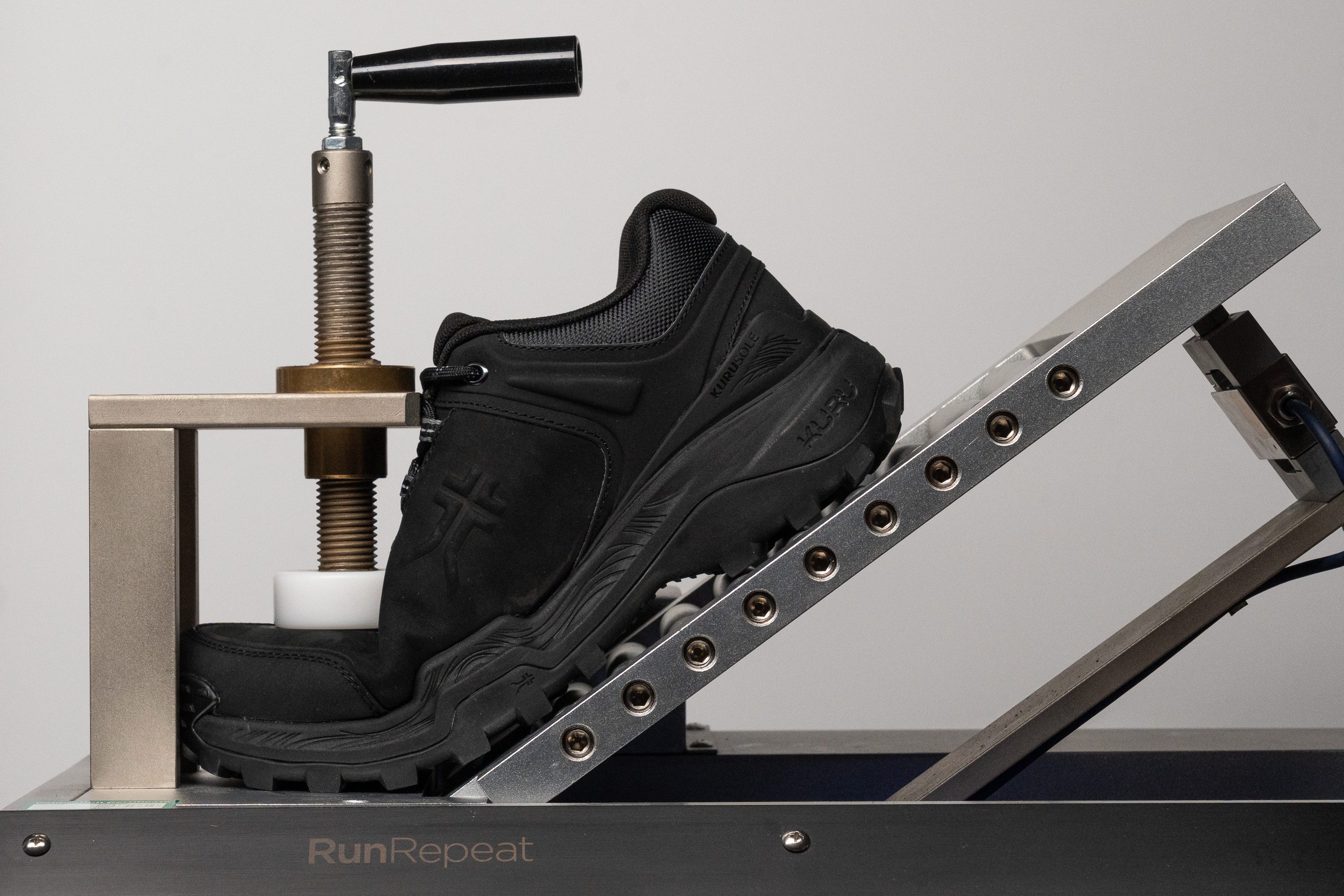
| Ridge Motion | 20.9N |
| Average | 18.3N |
Weight
At 16.2 oz (458g) in a men's US size 9, the KURU Ridge Motion is a heavy-set shoe that can feel cumbersome compared to many popular day hiking shoes on the market.
But the extra ounces might feel reasonable for hikers seeking orthopaedic foot support in their outdoor shoes above any other performance benefits.
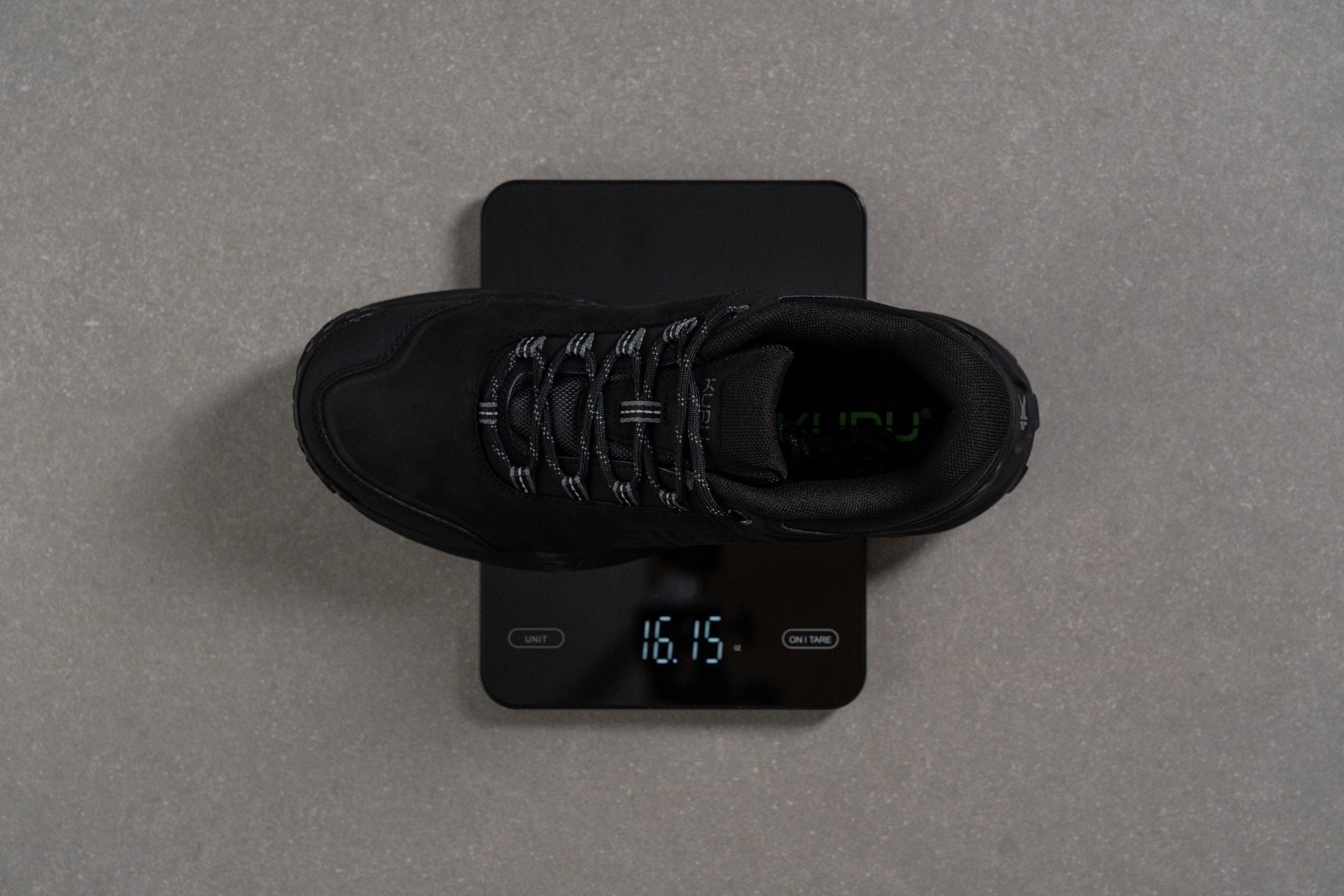
| Ridge Motion | 16.2 oz (458g) |
| Average | 13.4 oz (380g) |
Breathability
Although the Ridge Motion is not a waterproof shoe, its upper is made of thick leather that limits the airflow quite significantly.
Our breathability test showed that a very thin streak of smoke still managed to escape through the fabric panel on the shoe's tongue. But it wasn't enough to raise our breathability score any higher than 1 out of 5.
Having meticulously examined this KURU shoe's upper, we didn't find any hidden ventilation pockets or perforations.
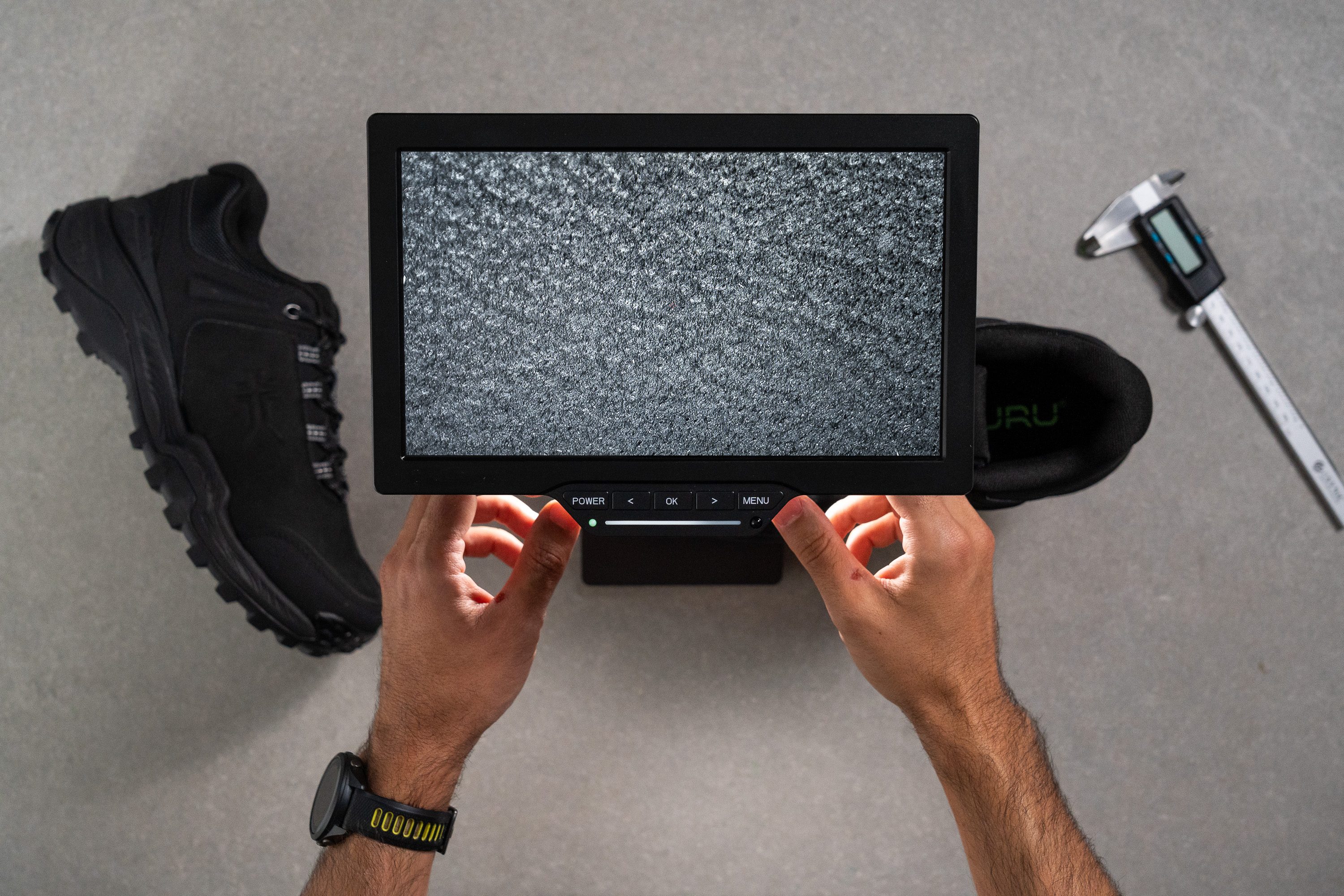
| Ridge Motion | 1 |
| Average | 2.4 |
Stability
Lateral stability test
The KURU brand prides itself on producing orthopaedic footwear, and it is reflected in the amount of support and stability offered by the KURU Ridge Motion.
The shoe is equipped with both internal and external stabilising components to keep the foot and ankle steady on unpredictable terrain out there in the wild.
Torsional rigidity
First of all, this KURU shoe proved to be incredibly rigid side-to-side and didn't lose its structure even one bit during our manual test. Because of that, its torsional stiffness deserves the highest score of 5/5.
Not only does this solid build keep the foot laterally stable on hilly terrain, but it also minimises torsional motion that can put stress on the foot muscles and tendons and potentially lead to plantar fasciitis, metatarsal strain, or other overuse injuries. Especially if you often carry a heavy backpack!
| Ridge Motion | 5 |
| Average | 3.7 |
Heel counter stiffness
In addition to its dynamic heel support underfoot, the Ridge Motion also features a robust heel counter around the heel and ankle.
Our manual test instantly revealed its immense stiffness, which resulted in another high score of 5/5. It helps to keep the rearfoot firmly anchored inside the shoe and minimises impromptu wobbling.
| Ridge Motion | 5 |
| Average | 3.7 |
Midsole width - forefoot
The landing area of this KURU shoe also turned out to be very broad and stable.
Our calliper measured the widest part of its forefoot at 116.2 mm, which is a few millimetres wider than average.
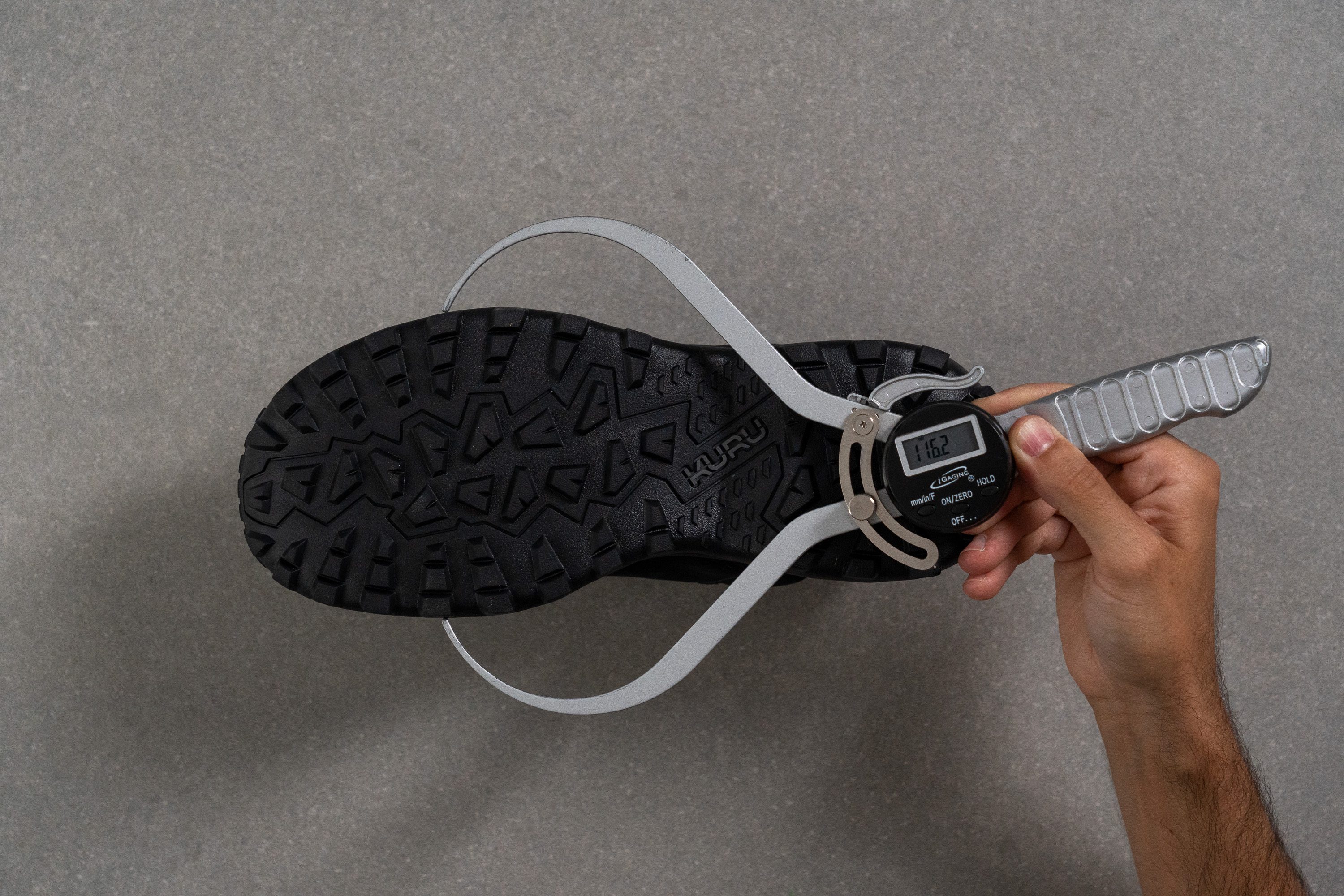
| Ridge Motion | 116.2 mm |
| Average | 111.3 mm |
Midsole width - heel
With another above-average reading of 91.9 mm, we also found that the Ridge Motion has a pretty extended heel.
Looking at the other chunky outdoor shoes we've tested, this KURU shoe's platform dimensions are the closest to the HOKA Anacapa 2 Low GTX.
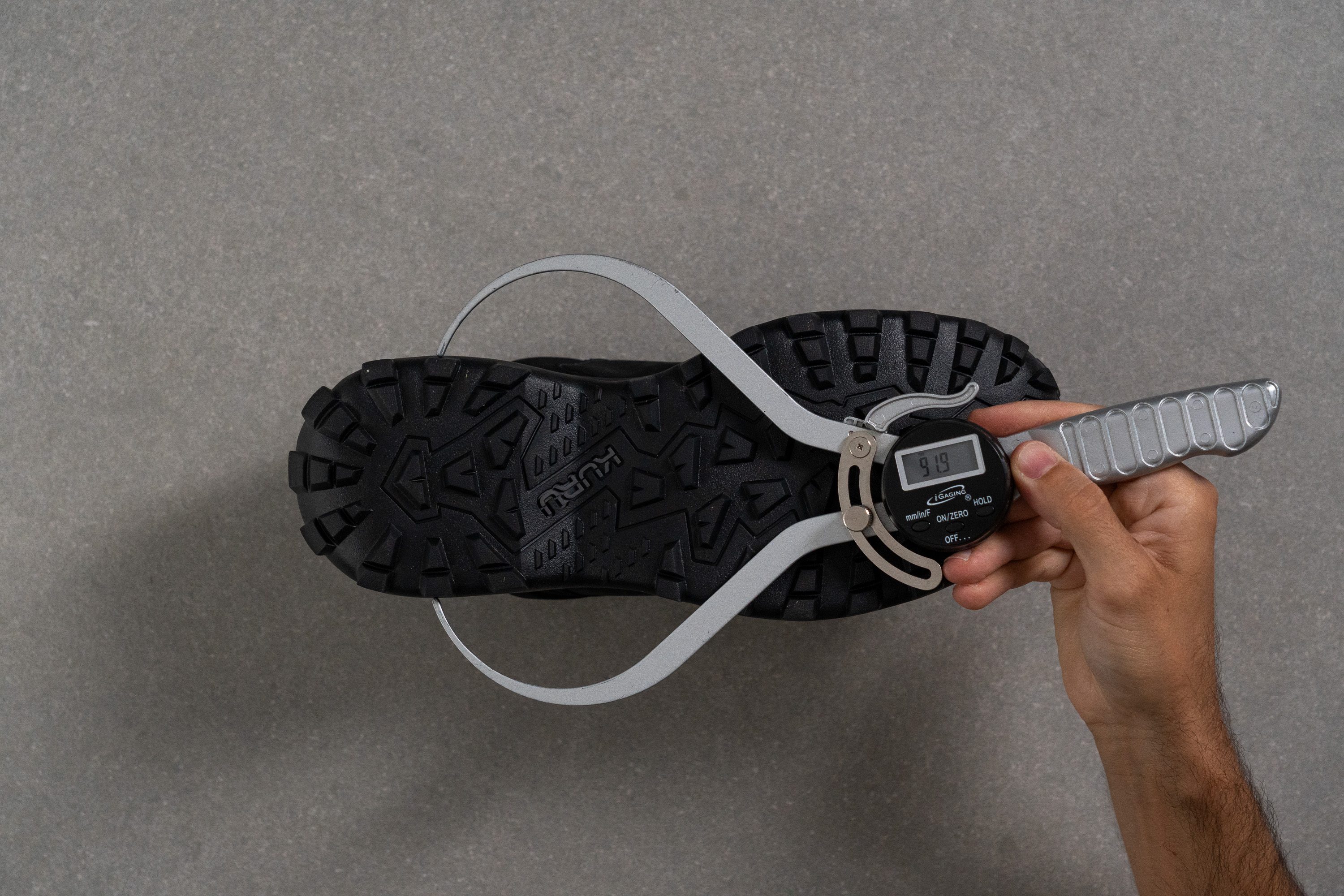
| Ridge Motion | 91.9 mm |
| Average | 87.9 mm |
Durability
Toebox durability
Positioned as the brand's 'most rugged hiking shoe yet,' we can only partially agree with that statement about the Ridge Motion.
Putting all hiking shoes through the same demanding Dremel test, we drilled the top of the shoe's toebox with sandpaper for 12 seconds. And we should give credit to its nubuck leather for holding up so well!
But because the tool left a noticeable dent, we had to subtract one point from the shoe's toebox durability to make it 4/5. But it still is a very reliable material that can withstand abrasive scrapes from rocks and bushes.
| Ridge Motion | 4 |
| Average | 3.7 |
Heel padding durability
Unfortunately, the shoe's collar lining turned out to be even less promising and developed a hole very quickly under the Dremel pressure.
The hole was so glaring that we didn't hesitate to lower the shoe's heel padding durability score to only 1/5.
| Ridge Motion | 1 |
| Average | 3 |
Outsole durability
We are also concerned about this KURU shoe's outsole durability. After our standardised drilling session, the shoe's rubber showed significant wear with a 1.4 mm dent!
That's some of the worst results we've got among hiking shoes, especially in this price range!
| Ridge Motion | 1.4 mm |
| Average | 1.0 mm |
Outsole thickness
Its rubber layer is not the thickest either, showing only 1.9 mm on our calliper.
In other words, the Ridge Motion is not as heavy-duty as it seems and will likely not last as long as many other outdoor shoes.
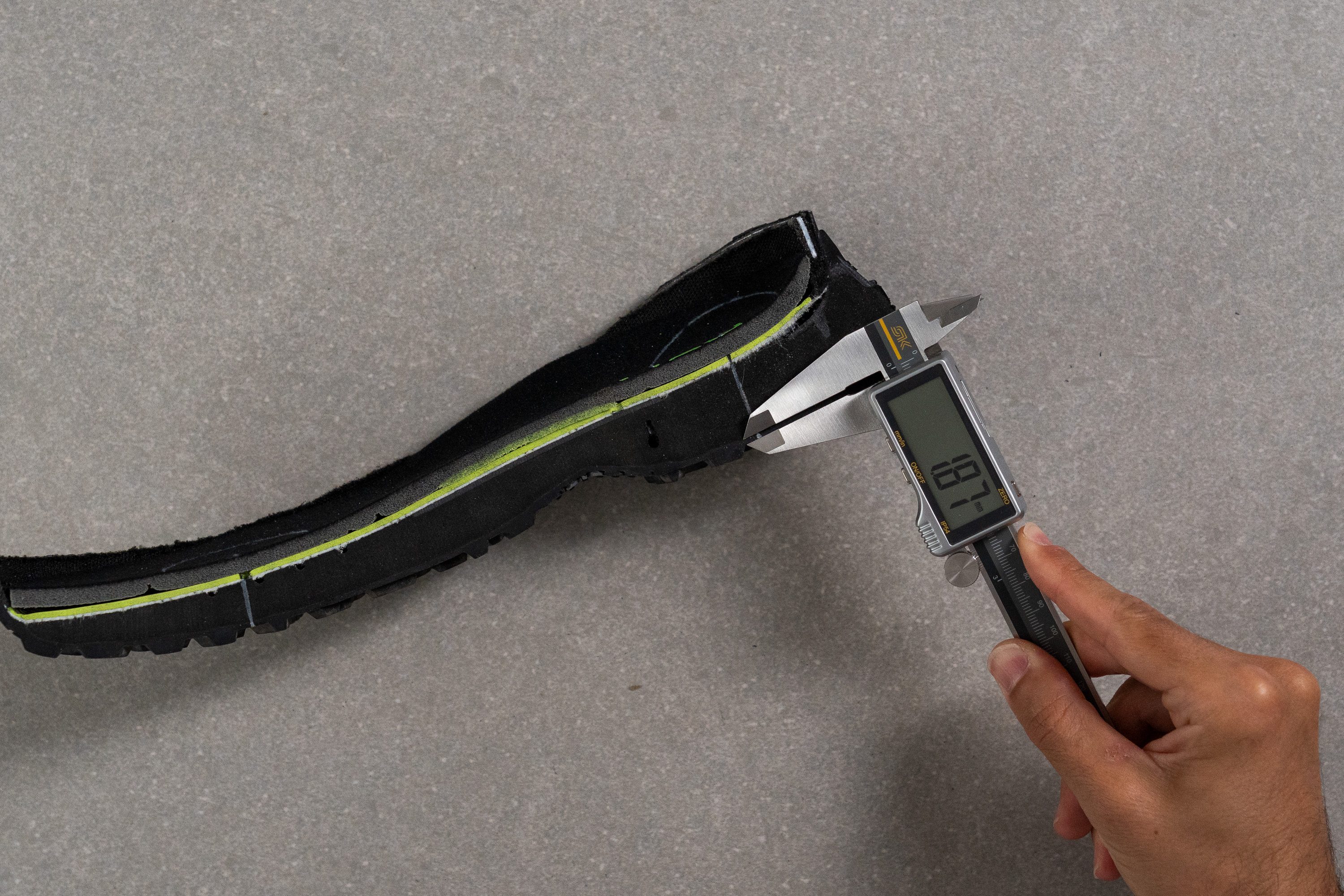
| Ridge Motion | 1.9 mm |
| Average | 2.5 mm |
Misc
Insole thickness
The Ridge Motion carries the brand's proprietary Ultimate Insole, which is fine-tuned for comfort and arch support. It makes the shoe even more suitable for hikers with flat feet and overpronation.
The insole showed a standard thickness of 5.5 mm in the heel.
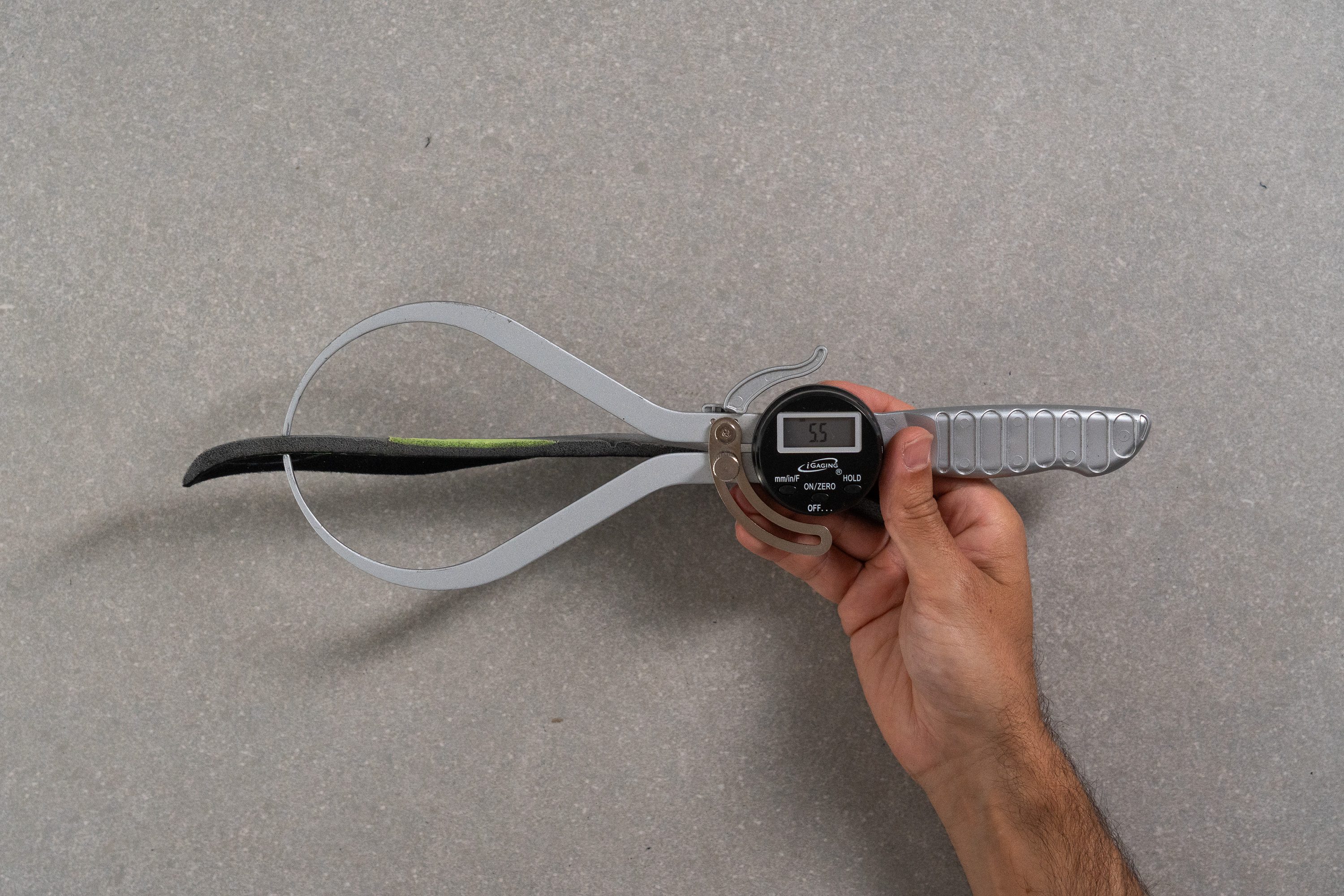
| Ridge Motion | 5.5 mm |
| Average | 5.3 mm |
Removable insole
You might as well swap the stock insole for a custom orthotic if you need a different kind of underfoot support.
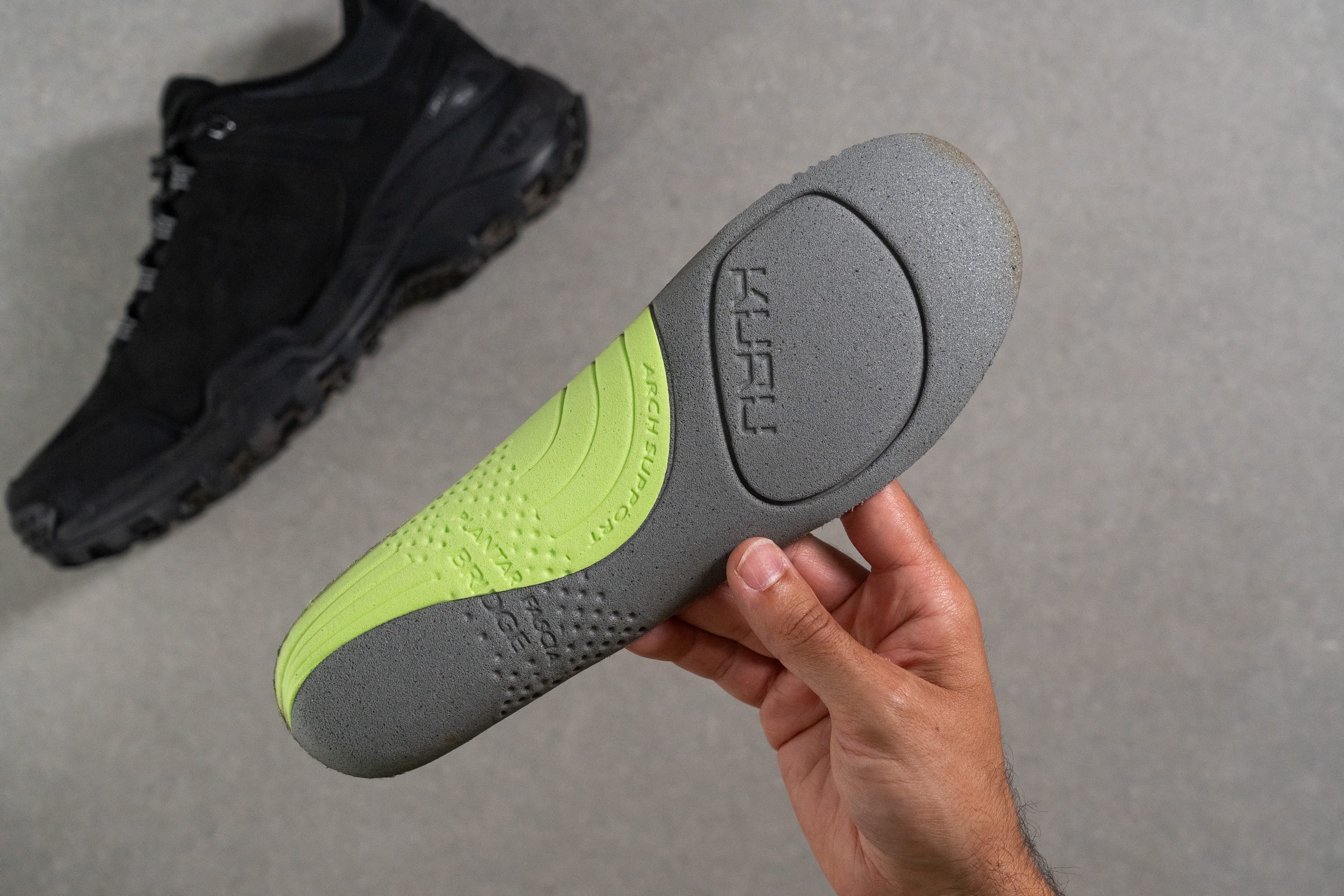
| Ridge Motion | Yes |
Midsole softness in cold (%)
If you plan to wear this KURU shoe in low temperatures frequently, keep in mind that its midsole will get notably firmer. Our 20-minute freezer test confirmed that its midsole foam firms up 23%. It will take some breaking in to return the shoe to its room temperature softness.
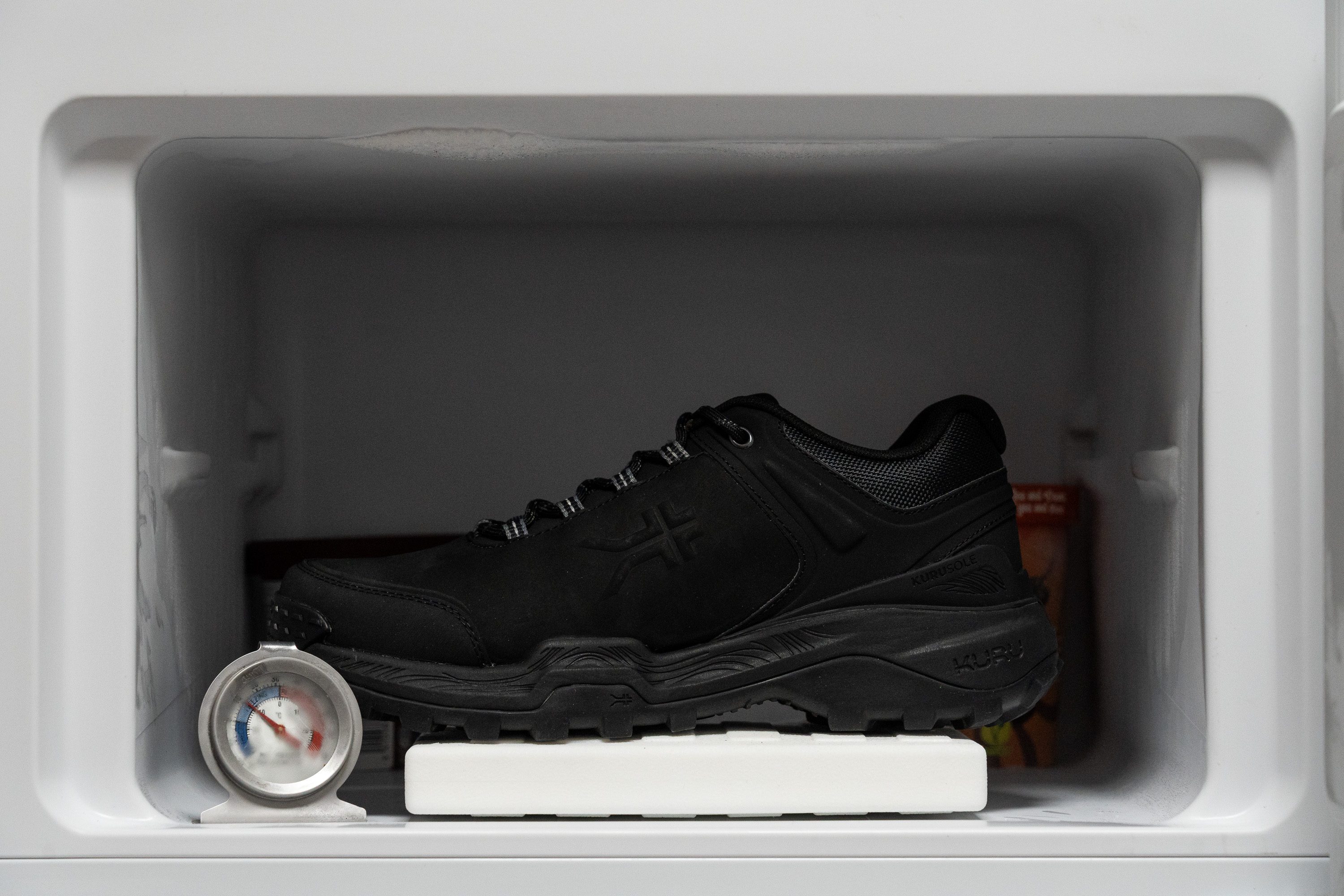
| Ridge Motion | 23% |
| Average | 19% |
Reflective elements
Thin stripes on the shoe's webbed eyelets turned out to be reflective when we tested the Ridge Motion in dark conditions.
| Ridge Motion | Yes |
Tongue padding
KURU doesn't skimp on the in-shoe padding and made sure that the Ridge Motion's tongue is generously padded with foam. It showed an above-average thickness of 13.7 mm in our lab test.
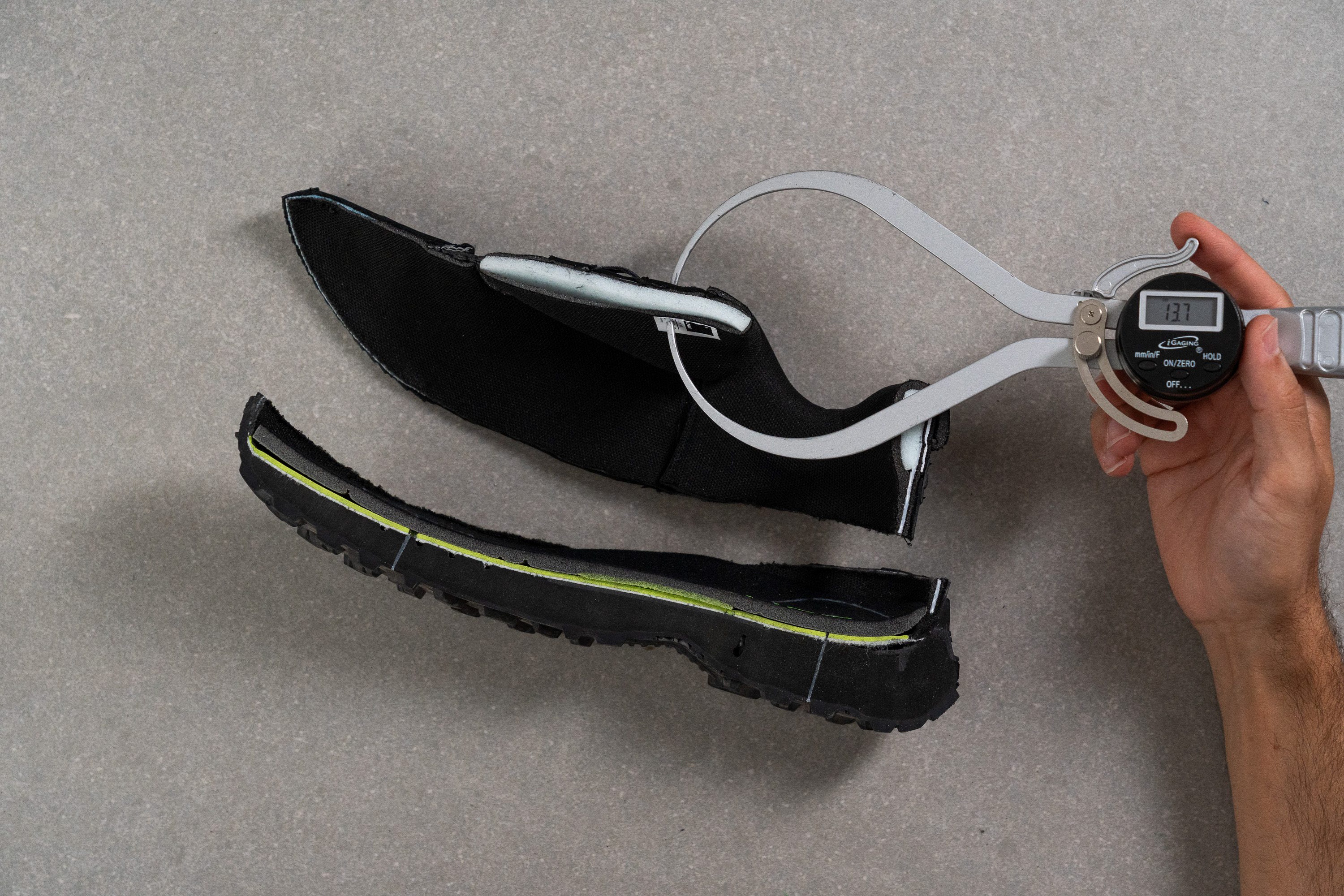
| Ridge Motion | 13.7 mm |
| Average | 10.2 mm |
Tongue: gusset type
The shoe's tongue is fully attached to the upper on both sides, minimising the chance of water and debris entering the shoe. It also helps to create a more locked-in and secure fit.
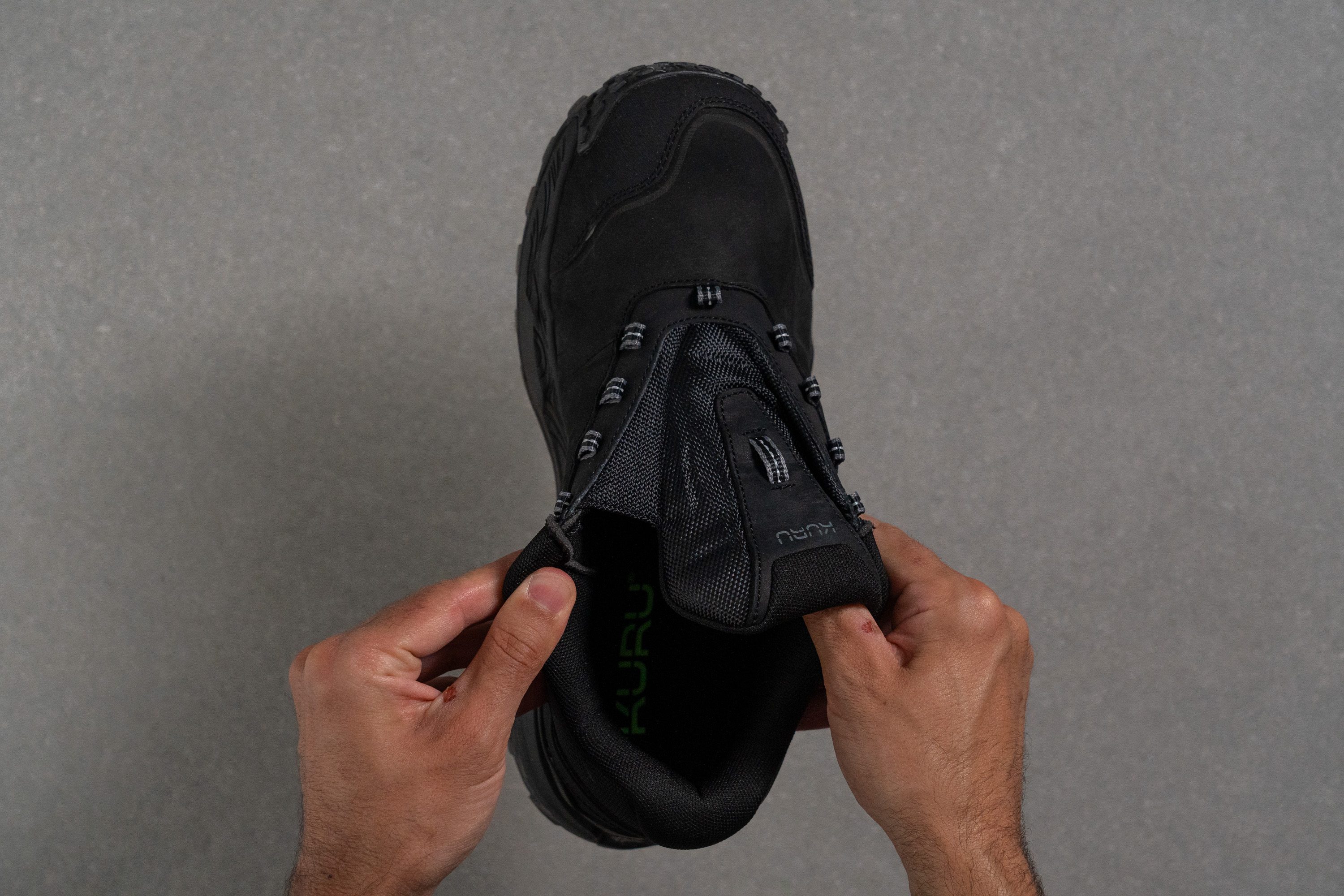
| Ridge Motion | Both sides (semi) |
Price
KURU shoes are not the cheapest, and the Ridge Motion has a pretty high asking price as well. As our lab tests showed, you can actually find better-performing trail shoes from HOKA, Adidas, and other brands at the same price point.
However, if your feet require orthopaedic support above anything else, it may be worth investing in this KURU shoe. Especially given that it is HSA/FSA eligible, which means that you can purchase it using money from a Health Savings Account (HSA) or a Flexible Spending Account (FSA) in the USA.
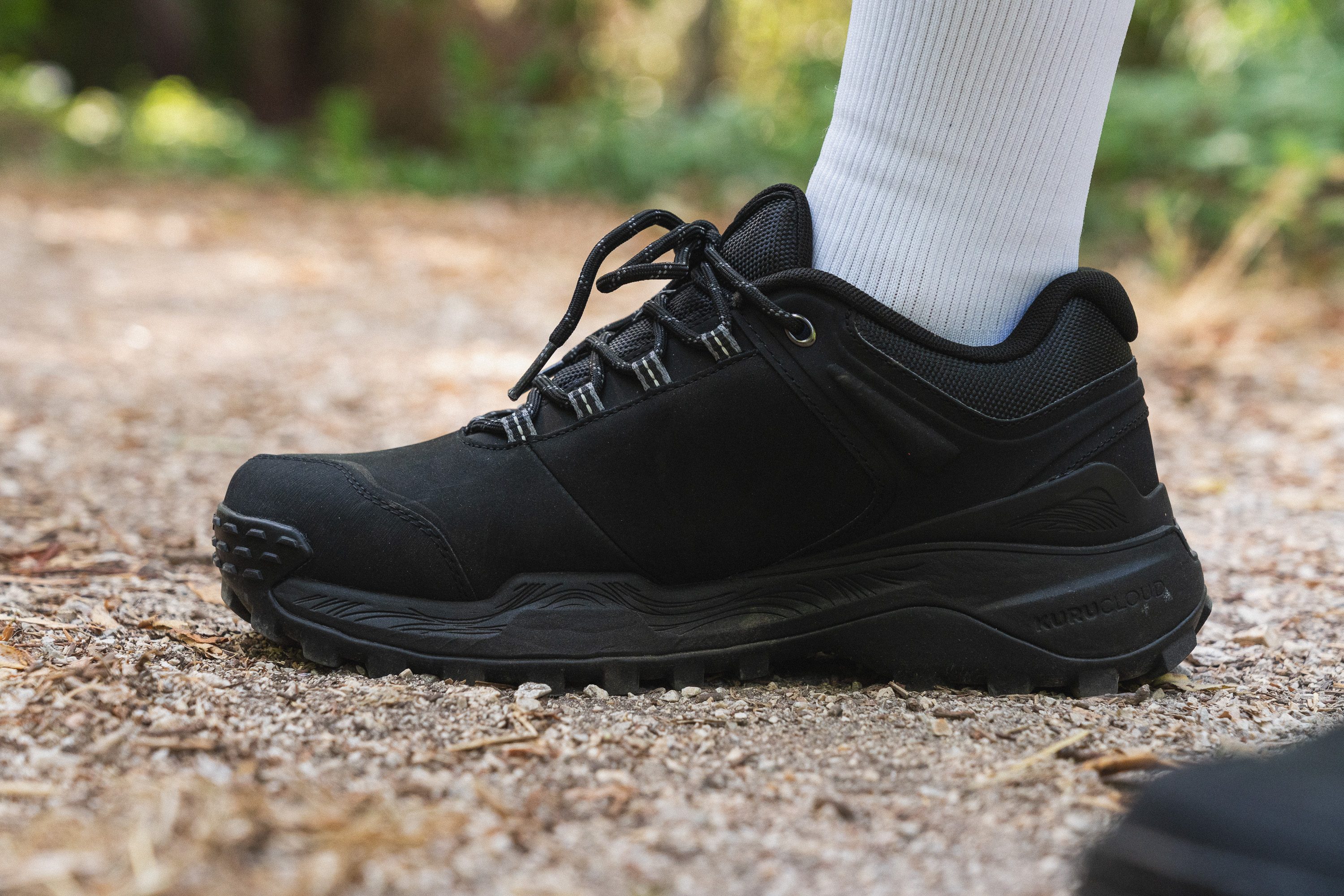
| Ridge Motion | $180 |
Heel tab
There is no heel tab, but the on-and-off is pretty easy thanks to the shoe's structured heel counter.
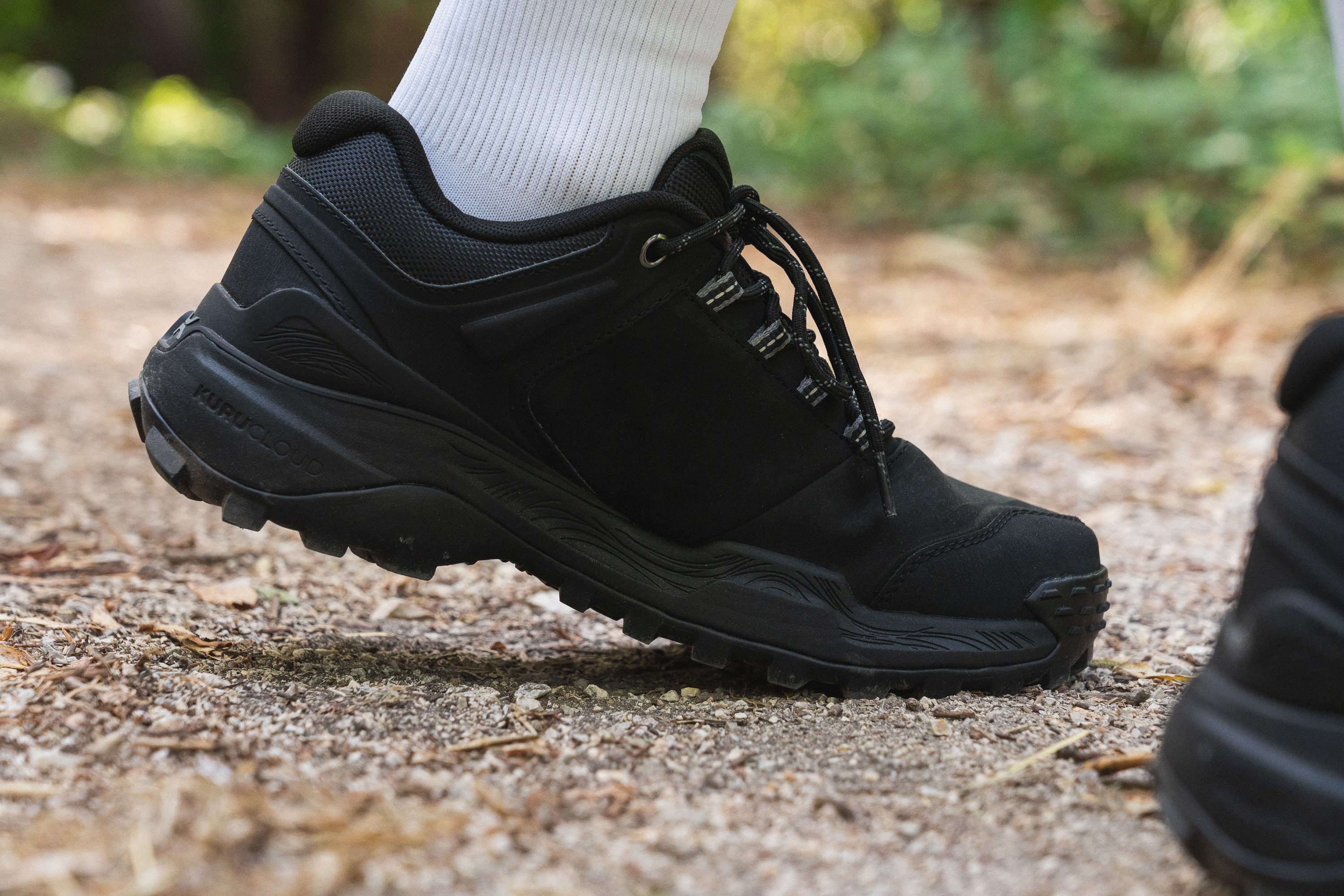
| Ridge Motion | None |

